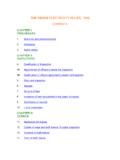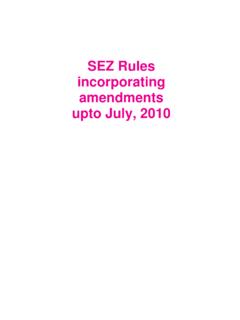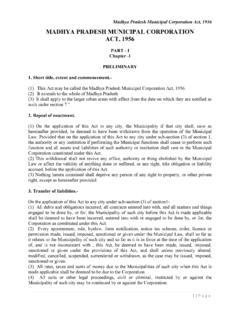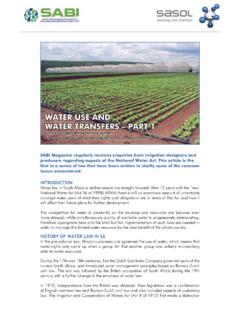Transcription of THE WATER ACT, 1956 (ACT 54 OF 1956 ) AND ITS …
1 THE WATER ACT, 1956 (ACT 54 OF 1956 ) and its REQUIREMENTS IN TERMS OF WATER SUPPLIES FOR DRINKING WATER AND FOR WASTE WATER TREATMENT AND DISCHARGE INTO THE ENVIRONMENT 1. INTRODUCTION The provisions of the WATER Act are intended, amongst other things, to promote the maximum beneficial use of the country s WATER supplies and to safeguard WATER supplies from avoidable pollution. The drinking WATER guidelines are not standards as no publication in the Government Gazette of Namibia exists to that effect. However the Cabinet of the Transitional Government for National Unity adopted the existing South African Guidelines (461/85) and the guidelines took effect from 1 April 1988 under the signature of the then Secretary for WATER Affairs.
2 The sections of the WATER Act that relate to the discharge of industrial effluents are: - Section 21(1) which states that -- The purification of waste WATER shall form an integral part of WATER usage and -- that purified effluents shall comply with the General Standard Quality restrictions as laid out in Government Gazette R553 of 5 April 1962 and - Section 21(2) which further stipulate that this purified effluent be returned as close as possible to the point of abstraction of the original WATER . Where a local authority has undertaken the duty of disposing of all effluents from an industrial process the provisions of Section 21(1) and 21(2) apply to the local authority and not the producer of the effluents.
3 If there is difficulty in complying with these provisions then the applicant may apply for an exemption from the conditions in terms of Section 21(5) and 22(2) of the WATER Act. The Permanent Secretary after consultation with the Minister may grant the issuance of a Waste WATER Discharge Permit under Sections 21(5) and 22(2) subject to such conditions as he may deem fit to impose. After independence, the Government of the Republic of Namibia decided that for the interim the existing guidelines will continue to be valid and to remain in use until a proper study has been conducted and new standards have been formulated (Article 140 of Act 1 of 1990). 2. GUIDELINES FOR THE EVALUATION OF DRINKING- WATER QUALITY FOR HUMAN CONSUMPTION WITH REGARD TO CHEMICAL, PHYSICAL AND BACTERIOLOGICAL QUALITY WATER supplied for human consumption must comply with the officially approved guidelines for drinking- WATER quality.
4 For practical reasons the approved guidelines have been divided into three basic groups of determinants, namely: - Determinants with aesthetic / physical implications: TABLE 1. - Inorganic determinants: TABLE 2. - Bacteriological determinants: TABLE 3. CLASSIFICATION OF WATER QUALITY The concentration of and limits for the aesthetic, physical and inorganic determinants define the group into which WATER will be classified. See TABLES 1 and 2 for these limits. The WATER quality has been grouped into 4 quality classes: - Group A: WATER with an excellent quality - Group B: WATER with acceptable quality - Group C: WATER with low health risk - Group D: WATER with a high health risk, or WATER unsuitable for human consumption.
5 WATER should ideally be of excellent quality (Group A) or acceptable quality (Group B), however in practice many of the determinants may fall outside the limits for these groups. If WATER is classified as having a low health risk (Group C), attention should be given to this problem, although the situation is often not critical as yet. If WATER is classified as having a higher health risk (Group D), urgent and immediate attention should be given to this matter. Since the limits are defined on the basis of average lifelong consumption, short-term exposure to determinants exceeding their limits is not necessarily critical, but in the case of toxic substances, such as cyanide, remedial measures should immediately be taken.
6 The overall quality group, into which WATER is classified, is determined by the determinant that complies the least with the guidelines for the quality of drinking WATER . TABLE 1: DETERMINANTS WITH AESTHETIC / PHYSICAL IMPLICATIONS DETERMINANTS UNITS* LIMITS FOR GROUPS A B C D** Colour mg/l Pt** 20 Conductivity mS/m !at 25 C 150 300 400 400 Total hardness mg/l CaCO3 300 650 1300 1300 Turbidity ** 1 5 10 10 Chloride mg/l Cl 250 600 1200 1200 Chlorine (free) mg/l Cl 0,1- 5,0 0,1 5,0 0,1 5,0 5,0 Fluoride mg/l F 1,5 2,0 3,0 3,0 Sulphate mg/l SO4 200 600 1200 1200 Copper g/l Cu 500 1000 2000 2000 Nitrate mg/l N 10 20 40 40 Hydrogen Sulphide g/l H2S 100 300 600 600 Iron g/l Fe 100 1000 2000 2000 Manganese g/l Mn 50 1000 2000 2000 Zink mg/l Zn 1 5 10 10 pH** pH-unit 6,0 9,0 5,5 9,5 4,0 11,0 4,0 11,0 * In this and all following tables l (lower case L in ARIAL) is used to denote dm3 or litre ** All values greater than the figure indicated.
7 ** Pt = Platinum Units ** Nephelometric Turbidity Units ** The pH limits of each group exclude the limits of the previous group TABLE 2: INORGANIC DETERMINANTS DETERMINANTS UNITS LIMITS FOR GROUPS A B C D* Aluminium g/l Al 150 500 1000 1000 Ammonia mg/l N 1 2 4 4 Antimonia g/l Sb 50 100 200 200 Arsenic g/l As 100 300 600 600 Barium g/l Ba 500 1000 2000 2000 Beryllium g/l Be 2 5 10 10 Bismuth g/l Bi 250 500 1000 1000 Boron g/l B 500 2000 4000 4000 Bromine g/l Br 1000 3000 6000 6000 Cadmium g/l Cd 10 20 40 40 Calcium mg/l Ca 150 200 400 400 Calcium mg/l CaCO3 375 500 1000 1000 Cerium g/l Ce 1000 2000 4000 4000 Chromium g/l Cr 100 200 400 400 Cobalt g/l Co 250 500 1000 1000 Cyanide (free)
8 G/l CN 200 300 600 600 Gold g/l Au 2 5 10 10 Iodine g/l I 500 1000 2000 2000 Lead g/l Pb 50 100 200 200 Lithium g/l Li 2500 5000 10000 10000 Magnesium mg/l Mg 70 100 200 200 Magnesium mg/l CaCO3 290 420 840 840 Mercury g/l Hg 5 10 20 20 Molybdenum g/l Mo 50 100 200 200 Nickel g/l Ni 250 500 1000 1000 Phosphate mg/l P 1 See note below See note below See note below Potassium mg/l K 200 400 800 800 Selenium g/l Se 20 50 100 100 Silver g/l Ag 20 50 100 100 Sodium mg/l Na 100 400 800 800 Tellurium g/l Te 2 5 10 10 Thallium g/l TI 5 10 20 20 Tin g/l Sn 100 200 400 400 Titanium g/l Ti 100 500 1000 1000 Tungsten g/l W 100 500 1000 1000 Uranium g/l U 1000 4000 8000 8000 Vanadium g/l V 250 500 1000 1000 * All values greater than the figure indicated.
9 Note FOR Table 2 on phosphate: Phospates are not toxic and essential for all life-forms. Natural WATER will, however, seldom contain phosphate; it is generally seen as an indicator of pollution and is usually accompanied by other pollutants. Wherever drinking WATER is combined with or consists wholly of reclaimed or recycled WATER , it may be expected to contain phosphate. The general guideline for a concentration level to be aimed at is 1 mg/l as P. But in many cases this may be difficult to achieve technically. For this reason the Department will allow a phosphate concentration level of up to 5 mg/l as P in WATER intended for human consumption. Please refer also to the Note on Phosphate under Section 3: General Standards for Waste/Effluent.
10 BACTERIOLOGICAL DETERMINANTS The bacteriological quality of drinking WATER is also divided into four groups, namely: - Group A: WATER which is bacteriological very safe; - Group B: WATER which is bacteriological still suitable for human consumption; - Group C: WATER which is bacteriological risk for human consumption, which requires immediate action for rectification; - Group D: WATER , which is bacteriological unsuitable for human consumption. TABLE 3: BACTERIOLOGICAL DETERMINANTS DETERMINANTS LIMITS FOR GROUPS A** B** C D* Standard plate counts per 1 ml 100 1000 10000 10000 Total coliform counts per 100 ml 0 10 100 100 Faecal coliform counts per 100 ml 0 5 50 50 E. coli counts per 100 ml 0 0 10 10 * All values greater than the figure indicated.






